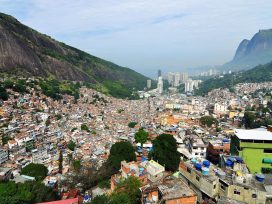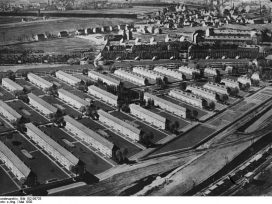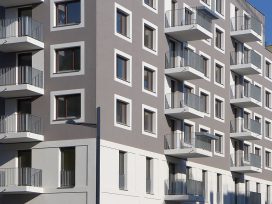Almantas Samalavicius: In your book How Green is Your City? you present rankings of US cities based on their current level of sustainability according to data available for the period 2004-2006. Though I personally am sceptical of any kind of ratings, one cannot deny that many people worldwide base their opinions of many contemporary institutions on precisely these sorts of ratings. Do you see these rankings as having any practical use? Have they helped raise people’s awareness of how their cities perform, as viewed from the perspective of sustainability? Have helped to establish some important sustainable practices on a local and national scale? To what degree they have been applied internationally?
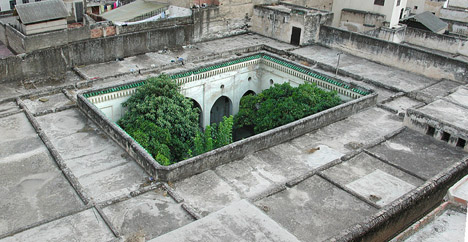
Photo: UrbanGrammer. Source:Flickr
Warren Karlenzig: Yes, my book How Green is Your City? The SustainLane US City Rankings (New Society Publishers, 2007) turned out have an impact in various ways. To provide some perspective, the rankings, which first were first published online in 2005, collected and compared 2000 points of data or information on the largest 50 US cities by population. The study was the first to compare US city performance by aggregating now-standard categories of analysis including Leadership in Energy and Environment Design (LEED) buildings per capita, community gardens per capita, farmers markets per capita, and the percentage of renewable energy used by a city. The study also statistically analysed and ranked on a relativity basis categories such as mobility modality (cycling, walking, carpooling, telecommuting); climate change programmes; collaborative innovation; sustainability planning knowledge and transparency; air and drinking water quality; solid waste diversion and recycling; housing affordability and green economic development.
As a result of this study, city leadership (mayors, etc.), particularly the laggards, began actively to compete to achieve better results in the rankings. Cities took the important first step of hiring sustainability directors for their municipality. For example, Houston mayor Bill White appointed one in 2007, and the new director told me that I was the first call he made: Houston has since instituted aggressive green building projects, expanded public transit, public bicycle sharing and urban ecological restoration – the Buffalo Bayou project. Other cities that may have altered their course as a result of low rankings in the study reportedly included Los Angeles, Columbus (Ohio) and Indianapolis (Indiana) – I was told by various city insiders (mayors, sustainability officials) that these cities created new initiatives directly in response to these national rankings.
In the case of Columbus, there was a 2006 news conference held on the steps of city hall with Mayor Michael Young admonishing the results of the study’s web publication, which ranked Columbus number 50 out of the 50 largest US cities. By the time a web-based 2008 ranking was completed that was based on a similar methodology, which was led by my colleague Ken Ott, the city advanced to number 30 out of 50 through more diligent sustainability management, new policies (the Get Green Columbus and GreenSpot programs) and projects. The current mayor of Atlanta and others in the past (such as Chicago Mayor Richard Daley) have publicly stated they wanted to be #1 in the How Green is Your City/ SustainLane rankings. That could have been a way to rally the troops, or, the more cynical might say, to get votes.
Other studies, organizations and authors cited and acknowledged – and appeared to at least partially model programs or studies based on the “How Green is Your City?” methodology. Examples include the Siemens Green City rankings, which was performed by the Economist Business Intelligence Unit; the US Star Communities Index; and a wide variety of international academic and governmental literature, including studies published by the World Bank and the American Planning Association. I’ve lectured on the US city rankings and related international policy development for graduate and undergrad programs at Stanford University, the University of Chicago, University of California at Berkeley, the University of Pennsylvania, Seoul National University and the Technikum in Vienna, among others.
There was also impact by the study on the general public and media. The rankings achieved upwards of three billion media impressions (based on number of readers for each publication and listenership/ viewership for broadcasts, etc.) I was interviewed in what at the time were virgin “markets,” such as the southeast US, where the concept of “sustainability” was controversial or largely unknown. It could be argued that the rankings provided a mirror by which people could intuit this new development through how they and fellow denizens behaved–driving or taking public transit, buying local produce from regional food producers. It also provided examples of how local governments and NGOs performed in collaborating on issues of local concern, like air pollution, drinking water quality, park space, land use and housing affordability, and how transparent they were overall.
To my surprise, interest in how I measured city sustainability performance in US cities has been particularly responsive on the international front. Several nations, including South Korea and China, reacted to the rankings by inviting my consultancy Common Current to tour their nations and meet with national, state, local and civil society leaders. For instance, I was invited to Beijing to meet with senior strategists affiliated with the State Council, the supreme political and strategy body of China. In 2010 we met for three or four hours about the ranking methodology in the part of the Forbidden City, known as Zhongnanhai, which is the private and highly secure inner sanctum of Chinese leadership where Chairman Mao formerly resided. Since that meeting, Common Current has provided sustainability planning and development strategy for the Nansha Eco-District in Guangzhou, planned to have one to five million inhabitants by 2025, and which is located at the very centre of China’s most populous metro region. Or, in Beijing last year, Common Current helped leaders of the metro region of 30 million with strategic plans for water supply, re-use and demand management, as Beijing is one of the world’s largest most water-starved cities.
For the national Ministry of Housing and Urban-Rural Development (MOHURD), I worked with a Sino-US team on the creation of software for managing the 663 largest cities in China in accordance with 33 key performance indicators – in conjunction with the US Department of Energy’s Lawrence Berkeley National Laboratory. Starting in 2014 with the initial implementation of that key performance indicator software, the initiative has short-term potential to directly impact seven to eight hundred million people. This may be critical to instituting a more effective management performance matrix for climate change and other pressing challenges – including dangerous air and water quality – as China’s urban population grows to more than one billion by 2035.
AS: As we know, so far the United States has refused to sign the Kyoto protocol – one of the most important documents of the recent period if one takes into consideration ongoing crises and the pressure of the increasingly large threat posed by climate change this century. However, a large number of voluntary organizations, associations and institutions in the United States are involved in work for a “greener” urban future. Can we speak about the significant rise of awareness in sustainability issues during recent decades, say ever since Paul Ehrlich published his famous pamphlet The Population Bomb? As a consultant to so many business institutions do you see a breakthrough in their representative’s mental attitudes, in corporate policies and practices?
WK: As for the term “sustainability” I had not heard of it until about 1993, when I was consulting with the Clinton White House. For many years, I have tried to carefully make a distinction between “sustainability” and “environmentalism”. Beyond the definition provided by the Brundtland Commission in Our Common Future in 1987, I see sustainability as a concept that relates more specifically and explicitly to the design of the future, whereas “environmentalism” was historically about protecting land, species and people, with an emphasis on activism (including protests) and biology-based education. By contrast, sustainability and, particularly, resilience, are committed to planning and designing a viable future based on various integrated disciplines (science, economics, geography, architecture, agriculture, climate) including human and societal components, against an emerging backdrop of probable climate risk, new technologies and collaborative capacities.
Ehrlich and others (from Rachel Carson and Barry Commoner to Greenpeace and Earth First!) alerted people to limits of resources, along with ecosystem, species and habitat destruction, while authors and leaders including Jane Jacobs, Paul Hawken, Hunter and Amory Lovins, Janine Benyus, Donella Meadows, Hermann Daly, Robert Ayres and David Holmgren awoke people to importance of using system approaches to maintain (bio)diversity while illuminating and enabling new forms of collaboration, economics and design.
To put it another way, environmentalism highlighted the pollution problems associated with cars and sought to limit their use, while sustainability looks at how cities such as Helsinki and Hamburg can move toward becoming car free by re-envisioning the design and functions of public space through creative planning, attractive and accessible public transit, low-carbon technologies and the “sharing” or “collaboration economy”.
AS: Which are the best among the latest urban practices in the US context as far as sustainability is concerned? And which ones you would outline as fruitful and/or promising? Has there been a significant shift in the thinking and attitudes of urban municipal and local authorities? If so, which of them you would specify as “exemplary” or the most promising?
WK: Earlier this year, for a series of lectures I gave in Austria through the US Department of State, I published some posts on a concept I called “Smart hives and swarms”. The gist of the idea is that so-called sustainable “Smart Cities” will not only emerge from monolithic architectures being proposed by major international technology corporations and others such as the European Union in its Horizon 2020 program, but rather will consist of a bottom-up facilitation of daily functions (that happen to be more sustainable) through countless apps being used by citizens, the private sector and government. These apps are particularly evident in the mobility sector, and are emerging in energy, food and resource areas. They might inform people where they can find: modes of public or even free shared transit, ripe fruit to glean (speaking of fruitful!), walkable housing or lodging, construction equipment, or city-based investment opportunities, to name a few. Online communities like Bay Area Urban Homesteading are setting up expertise networks, work parties and events to make resilience knowledge more explicit. Like virtual beehives, the “sharing economy” reduces ownership in the name of collective economies, without all the cult-like entrapments of the commune.
The sharing economy is becoming more evident in San Francisco-Silicon Valley, the birthplace of Uber, Lyft, AirBnB, SideCar, Yerdle, (and of course Facebook, Twitter and Google). The Bay Area is also home to new collective intelligence or crowdsourced applications such as Opower that let users compare their energy use in their home or business with those in their neighborhoods, which are more likely to have similar social-economic and climatic profiles. Microgrids, community food production and sharing, as well as peer-to-peer information based systems are all compatible with the sharing economy. New information sources such as the non-profit WalkScore, out of Seattle, rates properties in cities based on how many amenities can be accessed within walking distance, and it’s influencing not only where and how people get around, but it is becoming a strong influencer for real estate purchases and whether or not someone takes a job. Would I be working in a sterile, private-car-beholden corporate campus, or in a vibrant mixed-use neighbourhood surrounded by cafes, art galleries and public parks, and accessible by public mobility on demand? You just enter the address you are interested in, and you will get a walkscore (from 1 to 99) and localized map of walkable cafes, bars, schools, playgrounds, libraries, stores, etc.
Of course, there are complicated issues in the sharing economy with insurance, local taxes and liability that need to worked out further. And these applications are not yet addressing a big issue in San Francisco and other US cities: the high cost of living partially based precisely on the success of such companies, which drives out long-time non-tech industry residents, including teachers, artists and child-care workers, as well as the elderly and those on the wrong side of the digital divide.
On the positive side, cities such as San Francisco, Vancouver and New York City are opening up their application interfaces to programmers to enable more apps to be built around mobility needs, real-time parking pricing, interactive public maps, and digital-physical community design improvement projects such as parklets. These present opportunities to improve quality of life while reducing carbon emissions. Even when the data might not be open, it is being hacked for public benefit. A programmer in Paris visualized the Velib bicycle share system – which has changed that city’s culture and access more than any city’s bikeshare program – so people could see in real-time where bicycles are available, as the bike sharing system is so popular, it’s hard to find an unused one these days. These information and resource sharing trends are also becoming evident in Amsterdam, Barcelona, Copenhagen and other (green) cities of Europe.
From a more top-down city-state or corporate approach, there are Asian cities including Singapore (congestion management, parking, public transit), Seoul (broadband access, public apps for GHG management) Shanghai (integrated public transit payment and logistics) and Rio de Janeiro (centrally managed dashboards for public safety; handheld disaster alerts) innovating.
Another significant and growing trend is planning for adaptation in the face of climate change. Good resilience examples include Copenhagen’s Saint Kjeld Kvarter district, Singapore’s city-as-global-“Hydrohub” knowledge centre as well as the Singapore Sports Complex; and Rotterdam’s new green economy optimized port and floating city district.
AS: There are some aspects of sustainability that ought to be reconsidered. As some critics have already observed on numerous occasions, there is often a gap between popular rhetoric and real actions. Public and institutional vocabularies these days are full of “green” labels, however, can we conclude that human behaviour is changing or has already changed to pursue goals of sustainability? And more generally, can society that has been subjected to unprecedented levels of production and consumption (especially during the last two centuries) embrace a worldview that departs from the one that was born in and dominated throughout the modern era?
WK: Speaking from my personal experience and observations, I have found society changing to at least accommodate the idea of being more green. Ten or 15 years ago, for instance, I found that those who rode bicycles for transportation were considered odd or even disruptive forces sabotaging vehicular-based traffic. Cycling rates in many US and European cities are rising dramatically – and I love seeing parents and their young children riding in cities together – while smaller gas-efficient cars, car-sharing services, and public transit use continue to show strong growth. People, whether they are home or business owners, are seeing that energy efficiency pays quick dividends including comfort and near-term financial returns, so people are downsizing their homes and are adopting new technologies, whether it is smart-phone controlled thermostats or triple-pane windows, not to mention photovoltaic solar.
Organic food and home gardens, even in small apartments, are becoming more common, with more and more urbanites of all social-economic backgrounds producing quantities of more sustainably produced fruit and vegetables. Another promising trend is urbanites raising or sharing laying hens, honeybees, etc. And then there has been the rise of the urban foraging, gleaning and surplus fruit exchanging movement in and around cities, particularly in Vancouver, San Francisco, Los Angeles, Oakland and Seattle, complementing local, handmade production of everything else organic, from pickles to beer, wine and spirits – along with yarns, bikes, clothing and furniture – in places like Brooklyn, New York or Portland, Oregon.
To some, these emerging markets or behaviours may seem trivial or non-significant. But when viewed ten years from now, they will be recognized as having chipped away at the military-industrial complex. During the latter decades of the twentieth century, particularly the 1980s and 1990s, there was a growing corporate stranglehold on our economies, livelihoods and activities right down to the foods we ate and ways we engaged in recreation, say, by taking a Sunday drive in the SUV to the shopping mall for chain store clothing outfits, industrialized foods and imported throw-away things. That all began to change with higher energy prices around 2005-2006 and then, of course, the Great Recession and global acknowledgement of climate change invalidated the economics of sprawl forever, an argument I made in the Post Carbon Reader (Post Carbon Institute, 2010). Now mass production and consumption are being challenged by the sharing economy, the maker movement and the urban homesteading of the younger generations.
In terms of addressing the overall industrial system of production, my hope is that an international price on carbon by 2020 will enable true pricing of products and services based on what are now considered by business-as-usual economists as “externalities” through the use of life-cycle analysis of energy (and thus carbon emissions) and also of water, minerals, compounds and biomass.
AS: Some renowned architects and social critics have been sceptical of such notions as “green” skyscrapers or earth-scrapers that consume, and cannot exist without consuming, large quantities of energy. Some critical minds even go as far as to suggest that if we continue to consume “green” i.e. solar or wind power at the same rate as we do presently, we should simply stop speaking of sustainability altogether. Do you share these attitudes? Can high-rise buildings, even if they use the most advanced technologies and chemical materials, really be regarded as sustainable or green? Do you think new technologies can provide a means of cultivating sustainable attitudes in the building industry and in settings of urban expansion?
WK: I would rather not label anything as being “sustainable” or “not sustainable” when it comes to human endeavours, but point out instead examples of thinking and doing that are “more sustainable” than business as usual or even than the current state-of-the-art. If we stop speaking of sustainability, that’s fine, too, as long as we correct or ignore and supersede the many errors or oversights of the industrial age. This century, there are office buildings that are zero net in terms of operational carbon: Common Current worked on the pre-planning for one in the Silicon Valley in 2008 and it became reality by 2013: The Packard Foundation headquarters in Los Altos, CA (EHDD were the designers). As for mixed-use skyscrapers, they are not as carbon- and resource-intensive as sprawled, single-family homes and disconnected chain store big-box shopping complexes in terms of energy consumption, especially when you consider transport to and fro, as well as land use. Elevators are nothing, using only five per cent of a building’s energy, compared to single-use residential subdivisions, or tropical resorts constructed for wealthy jetsetters on sensitive beachfront ecosystems.
Skyscrapers do however have massive energy and resource efficiency limitations in the materials used and infrastructure needed to support their construction and operation. Not only am I not aware of any skyscraper that is zero net energy, but I don’t know of any skyscraper that has used life cycle analysis for all of its materials (The Australian Life Cycle Society is undertaking a theoretical analysis on skyscraper material life cycle analysis, but that has not yet been applied to a site). Metals, stone, glass, chemicals, compounds and concrete are massive contributors to resource depletion, pollution and climate change, yet little is being done to effectively and systemically address the issue. I’m not saying it can’t be done, but to date it has not been accomplished. As I mentioned earlier, there should be a significant change by 2020 when there hopefully will be an international price on carbon, which will cascade into market structures for energy first, then into other resource life cycles.
AS: In an address to the Royal Institute of British Architects delivered in the nineties, the radical philosopher and historian Ivan Illich insisted on the capacity to build as an essential characteristic of being human (“To dwell is human. Wild beasts have nests, cattle have stables, carriages fit into sheds and there are garages for automobiles. Only humans can dwell. To dwell is an art. […] The human is the only animal who is an artist, and the art of dwelling is the part of the art of living.”) Can we regain the lost art of building? Can we regain the ability to dwell in a human way in a century that is already almost fully urbanized and most probably will continue to witness the growth of urbanism?
WK: For this I turn to others such as Pliny Fisk who designed a medical centre in Houston, Texas of all places, with living, breathing walls built with recycled metal from local scrap yards, or Richard Register and Kirstin Miller of Ecocity Builders, who are working globally to plan urban neighbourhoods reviving ancient forms of cultural wisdom, including integrated design for environment, aesthetic function and climate. We can look to the 20-story Agora Gardens apartment block rising in Taipei by Vincent Callebaut, which is shaped like a double helix infiltrated externally with greenery both for cooling inhabitants and for people near the building’s immediate surroundings. These types of solutions will become part of an arsenal to address urban heat island impact from climate change and the dehumanizing effect of nature deprivation. In any case, we are urbanizing the Earth’s population at a dizzying pace, so we best take most of our proverbial eggs in terms of innovation, ecology, climate, beauty and art – which includes nature – and carefully design them, place them or restore them as part of our city basket.
AS: What is your attitude to the tradition of building or to be more precise – traditional building? What I have in mind is not specific styles or traditional aesthetic qualities but the art of building using natural materials and technologies known to humans for ages? Can they help us to design a better common urban future? Or would you consider this a utopian or nostalgic view?
WK: In terms of cities, traditional building methods have a place in regards to bringing ancient practice into the future such as thermal massing, passive ventilation and courtyards. Buildings designed using materials such as straw bale construction are limited in terms of geographic applicability and scalability. But even traditional material such as wood has been used –once it was re-engineered – to structurally frame a ten-storey building. I love the idea of biophilic urbanism, combining nature and man-made materials for artful, functional purposes.
AS: Having acted as consultant and expert in many international urban sustainability projects which of the recent global developments have you found most promising. And more generally – what are your own forecasts on the future of “sustainable urbanism”? Can it and will it become an integral part of future urbanism?
WK: The cross-discipline collaboration in sustainability fields is only beginning, but it is quite exciting. This trend will need to continue in order to truly address the systemic challenges of economic inequalities, class and gender oppression, extreme urban population growth, vanishing resources and climate instability. In my personal sustainability journey, I have worked with engineers, technologists, biologists, real estate and affordable housing developers, affordable housing residents, architects, anthropologists, sociologists, economists, urban planners, inventors, artists, social activists, corporate executives, and nature advocates, along with many stripes of government officials. We will all need to develop an ability to better understand the lives, needs and dreams of every type of urban inhabitant, while cultivating an ability to share and innovate amongst one other. This will require a common language, and much of that emerges from education that informs about culture, art and literature, as well as technology, science and mathematics.
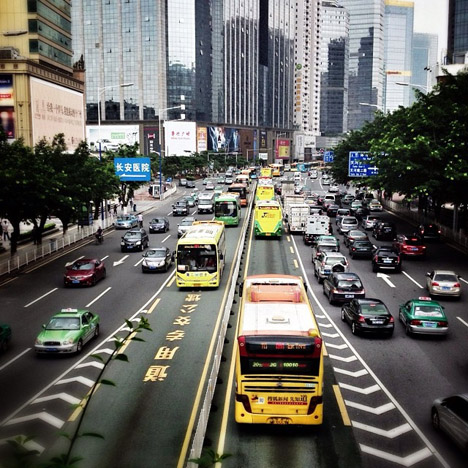
The Bus Rapid Transit (BRT) system in action in Guangzhou, China, 15 October 2013. Photo: KOP-SEE. Source:Flickr
In terms of exemplary projects, the Academy of Sciences building in San Francisco has a heating, cooling and ventilation system designed to utilize passive energy and fresh air from surrounding Golden Gate Park. The building has a large, iconic yet functional green roof, part of its design integration with the Academy’s educational mission on species and habitat depletion, and climate change. I also love the Bus Rapid Transit (BRT) system of Guangzhou, China. BRT uses platforms like train stations for ease of boarding, and dedicated transit lanes, which in Guangzhou are well integrated with walkways, bike ways and secure bicycle-sharing facilities. The system was opened only in 2010 at about one-fifth the price of a subway line, and since then it has had greater ridership than all the Bus Rapid Transit systems in Asia–more than 1 million daily trips. More than half the people riding bikes in Guangzhou these days are younger riders that never rode before because of the collapse and/ or government dismantling of China’s “Bicycle Kingdom” about ten years ago, but the multi-modal BRT made it imperative for them to learn now as adults!
In terms of green infrastructure, London is rewilding its eastern wetland, Upper Lea Valley, creating Europe’s largest urban wetland for flood control, water filtration and habitat for biodiversity. Back in San Francisco, I’m involved in a project with one of the largest US independent energy providers, in planning a redevelopment cluster for new innovation in resilience through distributed micro grid energy and power storage, including financing, collaborative end-uses and residential-commercial resource sharing models.
Future urbanism and sustainability – or whatever you want to call this multi-faceted, purposeful design quest to save ourselves and our planet’s other forms of life – will become inseparable within the next ten years. The only forces that can derail this evolution are warfare, large-scale terrorism or another economic meltdown on the magnitude of the Great Recession.
I’ve never found cities more daunting in terms of sheer size as they are now, with their dizzying speed of growth and unfathomable scale. I have also never been more excited or hopeful, however, about the students now entering our workforce and participating more fully in our society – they get it because they have to. Fortunately, we can look toward endless horizons of human, natural and technological natural potential in our cities to begin to seriously leverage our collective intelligence for the Earth’s betterment.
